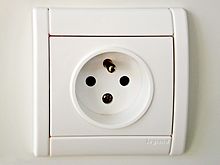Connector type E
The connector type E is a connector originating from France . It is also called 2P + T (2 pôles + terre) or also CEE 7/5 (socket) and CEE 7/6 (plug).
The plug has two round contact pins for the live conductor and for the neutral conductor . These are usually thicker than the contact pins of the Euro plug , but there are also variants with thin contact pins (4 mm). There is a contact opening offset in the middle that accepts the contact pin of the socket for the protective conductor. Due to its structure, the system is theoretically protected against polarity reversal if the relevant national standard so provides. CEE 7/7 device connection cables are not designed uniformly.
Pure type E plugs have become rare because they are increasingly being replaced by CEE 7/7 plugs (type "E + F"). In contrast to type E plugs, these can also be inserted into Schuko sockets and can therefore be used in large parts of Europe.
safety
- Reverse polarity protection
- The system is protected against polarity reversal due to the asymmetrical arrangement of the protective conductor . This could ensure, for example, that the live conductor is always connected to the base and not to the easier-to-touch socket thread of an incandescent lamp, or that a single-pole intermediate switch always interrupts the live conductor. However, the standard drafted for this purpose has not been implemented, so that manufacturers of the connection cables are not bound by any rule.
For the CEE 7/7 plug, polarity reversal protection only applies if it is used in a type E socket. However, their pin assignment is also not standardized. In the Czech Republic there is only a guideline with the character of a recommendation, according to which P and N are connected. In connection with Schuko sockets, the CEE 7/7 plug is not reverse polarity protected.
- Finger security
- The sockets are equipped with protective collars, so that touching live parts - such as the incompletely inserted pins - is prevented.
- Leading protective conductor
- The protective conductor is designed to lead, that is, when the plug is inserted, it is connected in front of the other two contact pins, and when it is pulled out, it is separated after these.
- Mechanical properties
- Due to the large surface area of the connector, the protective collar around the socket and the stable design of the protective conductor, type E is a very robust system that withstands mechanical stresses well.
- Electrical load capacity
- Fine fuses in the plugs are not provided, so that the only protection against overload is provided by the main fuse of the building installation, occasionally by fine fuses in the devices.
- Child safety
- Devices that prevent the introduction of objects are not provided. However, it is easily possible to produce sockets with an integrated protective device.
compatibility
The sockets can accept Euro plugs and contour plugs . Since CEE 7/7 plugs have also become common in countries that use the Schuko system, most devices bought there can be connected to type E sockets.
Since the contact pin for the protective conductor is located in the socket, the plugs can be plugged into some sockets without a protective conductor contact. This is especially true for plugs with 4 mm contact pins that can be plugged into a number of European sockets without the protective conductor being connected. A device connected in this way works; However, the protective conductor has no function, so that the housing of a defective device can be live. This type of connection is only recommended for fully insulated devices, which then (only) may be equipped with two-pole plugs without a protective conductor.
The system is similar to the old Swiss type 2 / type 14 due to the protective conductor protruding from the box , but is not compatible with it.
distribution
- Belgium
- France
- Morocco
- Monaco
- Poland
- Slovakia
- Czech Republic
- Tunisia
- many former French colonies
See also
Norms
- NF C 61-314 Prises de courant pour usages domestiques et analogues - systèmes 6 A / 250 V and 16 A / 250 V. - French standard
- NBN C 61-112-1 Prises de courant pour usages domestiques et analogues - Part 1: Règles générales / Contactdozen voor huishoudelijk en gelijkaardig gebruik - Deel 1: Algemene regels. - Belgian standard
- IECEE CEE-7 Specification for plugs and socket-outlets for domestic and similar purpose. 2nd edition 1963-05, changed 1973-08, 1974-06, 1975-09 and 1983-03.
Individual evidence
- ↑ http://www.elektroprumysl.cz/elektroinstalace/zasuvkove-obvody-dle-nove-csn-33-2130-ed-3 ČSN 33 2130 ed. 3 says: outer conductor on the left when looking at the socket with the earthing pin above


